Dania Hall
427 Cedar Ave. So.
West Bank, Minneapolis
CONSTRUCTION
The Hall was built in 1886 by the Dania Hall Building Association, which was in turn founded by Society Dania, an organization of Danish immigrants that helped other young Danes adjust to their new city. Dania hall was conceived to be a meeting place and cultural center. The land was sold to the Society by Louis Meldal, a one-time president of the organization, for $11,000. The Society hired Norwegian architect Carl Struck to design the building; Struck used a Victorian Eclectic design, combining Gothic and classical styles. The cornerstone was laid on June 5, 1886, Danish Independence Day, celebrated with a march and speakers. The completed building was dedicated on November 10, 1886, celebrated by 300 Danes, according to the Minneapolis Tribune.
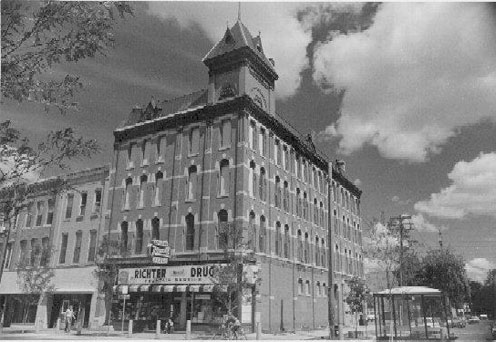
The building had four stories and a basement:
- The basement held offices, a kitchen, a dining hall, and J.M. Jackson’s Barber Shop.
- There were two storefronts on the first floor.
- The second floor housed six offices, including the office of the Society Dania, along with a billiard room, a library, a small hall with a stage, and the Society Dania fraternal rooms.
- The third floor was an open room 44 feet wide, 65 feet long, and 23 feet high, with a proscenium stage. 600 people could be seated on chairs. The curtain read Ej Blot Til Lyst (not for fun only), as did the curtain at the Royal Theatre in Copenhagen. The third floor was rented out for parties, dances, and where people went to see plays and vaudeville shows, often in their own Scandinavian languages.
- The fourth floor was a horseshoe-shaped balcony overlooking the third floor. It could seat 200 people.
The main entrance was on Fifth Street. Patrons entered through wrought iron gates with gaslit torches on either side. A wide wooden staircase led to the upper floors.
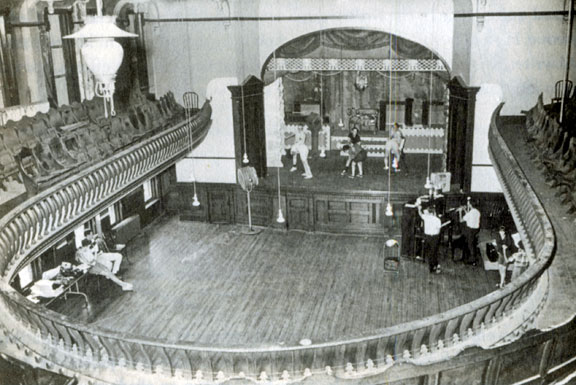
In 1896, the Society Dania purchased the building from the Building Association for $23,300, the amount of the remaining debt. The total cost of the building and land was $35,000.
1963
PHIL RICHTER
The story of the modern Dania Hall is really the story of pharmacist Phillip Jerome Richter. Richter was born on December 4, 1921, and grew up in North Minneapolis, graduating from North High. After graduating from pharmacy school at the University of Minnesota, he enlisted in the Army in 1944, where he worked with wounded and mentally ill soldiers in crowded hospital ships ferrying World War II troops back to the United States from the South Pacific.
He worked for another druggist for two years at 34th Ave. and 50th Street, and bought the drug store at Dania Hall from Seiver J. Moe in 1948. Moe had operated a hardware store in the other storefront on the first floor. The spot where Richter established Richter’s Rexall Drugs had been a drug store since about 1910. In 1963, Richter bought the building from Society Dania for $35,000. The Society Dania continued to use part of the building as a lodge hall.
Richter took a tolerant attitude toward the hippies and the bikers who congregated at his store, letting them use the phone, acting as an ad hoc doctor, lending money, holding their mail, etc. The store became what one underground newspaper dubbed the Heart of the West Bank.
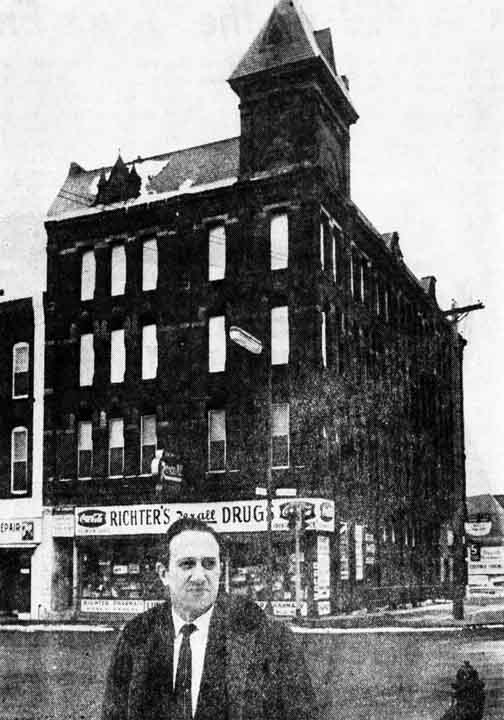
1964
MODERN DANCE
An article calling the hall “one of the oldest surviving vaudeville theaters in Minneapolis” announced that the Paul Taylor Dance Company was coming to teach a series of master classes sponsored by the Walker Art Center from August 10 to September 2, 1964. The classes were funded by a Rockefeller Foundation grant to the Walker.
Two events were scheduled in conjunction with the workshop:
- A lighting demonstration by New York set designer Tom Skelton
- A public concert by the Paul Taylor Company on August 30, 1964.
The article said that a gas lamp hangs from the domed ceiling, there are pulleys without ropes, painted sets leaning in dark corners, and a sign that strictly prohibited smoking and spitting. (Minneapolis Tribune, July 23, 1964)
1965
THE PLAY’S THE THING
In August 1965, the third floor theater, which hadn’t been used for a play in 30 years, was revived as a dramatic venue by the K & S Theater Players, headed by Steven Katz of St. Louis Park. The troupe had staged nine plays in different venues around town before settling in at Dania. Their first play at Dania was “Once Upon a Mattress” on August 5 – 8.
In his column, Don Morrison describes the scene:
The staged is framed with an ornate arch. The main drop curtain, which rolls down like a porch blind, probably had not been lowered for three decads and released a Niagara of accumulated dirt when the K & S people first tried it out. It bears a lugubrious postcard landscape of a castle, a lake and forested mountains. Danish, no doubt.
Backstage, the old scenery flats bear the scribbled names of theatrical greats who have played the Dania. I rather liked the proud blazon of the “Budapest Gypsies – April 17, 1936.” Among the roster of names was one Gypsy Yancho. Also is the despairing heartcry possibly written on the wall by an actor fallen from eminence: “O temore, O mores!”
Among unusual features of the Dania theater is a gas kitchen range in the ladies room – formerly utilized, I am told, for making tea.
(Minneapolis Star, July 14, 1965)
AND SO IT BEGINS
Richter remembered that the “weird people” began to show up in 1965, while he and his family were on a three week vacation to Mexico. When he returned, he asked employee Patricia Drake what she had done to his store. He said that many of the people who came were looking for drugs: “The only thing that irritated me about the drug business was they did more business than I did. The rolls these kids had were just fabulous.” The other major group were the bikers, who “were here for mostly one thing: s-e-x. There were a lot of runaways here on the West Bank.”
The 1965 date may have coincided with the new Washington Ave. bridge across the Mississippi River. The first University of Minnesota buildings appeared on the West Bank in 1961 (Walter W. Heller Hall) and 1962 (Blegen Hall and the Social Sciences Building).
1967
Columnist Barbara Flanagan mused, “I wish that somebody cared about good old Dania Hall.. It would take some doing, but it could be a showplace again the way it was when the Danes moved in.” She was given a tour by the live-in caretakers, Mr. and Mrs. Axel Christensen, who told her that the gas chandelier was the oldest gas lamp in the City and the gas company “would sure like to get their hands on it.” The building was still used as a meeting place for members of the Dania Lodge, and it was a rehearsal space for groups such as the Edgewater Eight. When asked if there was a Dania Hall ghost, Mrs. Christensen said, “I don’t know, but I do hear an occasional creaking at night.” (Minneapolis Star, December 15, 1967)
CONCERTS AT DANIA HALL
The building’s ballroom and its proximity to the U of M made it a logical venue for rock concerts. Only the roadies who had to haul the equipment up the stairs questioned the perfection of the venue. Dania Hall became the first of a progression of venues for late ’60s and late ’70s rock that continued with the Labor Temple and then the Depot.
In about in 1966, Gary Dale had a light show company called Light Fantastic, and every other week his show appeared with the Paisleys. Other names associated with Gary Dale were Dick Tatge, and Lee Fletcher.
On alternate weeks, Charlie Campbell’s Community News light show presented its own bands.
In June 1968, Gary and the Paisleys went to Canada, and, with Gary’s permission, Steve Barich took over the Light Fantastic name and did light shows and bookings.
Paisleys band member Peter Larsen told minniepaulmusic.com about the early days at Dania Hall:
The hall had a history to it. There were names inscribed all over the back of the stage that go back to the beginning of the theater. You felt a presence, even with no people there. There was a warmth… a character to the hall, the smell of the wood… all of the timber and resonating of the wood lent itself to the performance. These were the physical things and then there was the invisible that went along with this… a spirituality. It was built as a place for people to gather, to share and to communicate. If you were going to perform, that was the place to perform. It was a different awakening or happening.
The ambience and the sound contributed to this incredible atmosphere and it resonated with the music and the people. It was an open theater, one of the only kind in the city. It was a unique building. I just felt at home there with what we were doing back then.
Because of the incense and the beads, it was like going to church. It was akin to a religious experience.
Other bands that played the hall included:
- Noah’s Ark
- T.B.I. (True Blues Inc.)
- Jokers Wild
- Pepper Fog
- The Litter
- Lightning
- Pandemonium Side Show
- Mill City Blues Band
- Nicollet Island Peep Show
- Cold Duck
- Blue Sandalwood Soap
Finding information about these concerts is difficult; because building owner Phil Richter did not have a dance hall license, it was dangerous to advertise. Also, Steve Barich noted that there was no advertising budget… When one of the groups wanted to advertise, Richter applied for and received a dance hall license on December 29, 1967. At that time the building was inspected, and Richter was made to fix some cracked plaster over an unused balcony before the permit was approved.
ALDERMAN CHRISTENSEN ON THE WARPATH
Then on December 30, 1967, Alderman Jens Christensen attended one of two dances held at the hall, and when he got home he got a phone call from “a concerned citizen” who alerted him to two “fire hazards:” a door was locked to keep the second and third floor groups apart, and decorative plastic sheets that were hung from the balcony obscured exit signs. Based on this, Christensen ordered a top-to-bottom inspection, including plumbing, electrical, fire, and structural hazards. Inspection officials told Christensen that the initial complaints were outside the department’s jurisdiction. Richter accused Christensen of harassing him in order to get him to sell his building, presumably to Gloria Segal, who was redeveloping much of the West Bank. Keith Heller, Segal’s partner, denied this accusation.
1968
DANIA DANCES ARE HAPPENINGS
An article in the Minneapolis Star (February 8, 1968) brought the Wednesday and Friday night concerts by the Paisleys to the attention of Mr. and Mrs. Minneapolis, with the headline, “Dania Hall Dances Are ‘Happenings.’” The article stressed the fellowship aspect of the event witnessed by the unnamed reporter. Police officer Donald Reynolds, who worked at the dances three nights a week, said:
They’re a group apart alright. You should see them Friday or Saturday night. Three or four hundred come, and they wear costumes – rebel outfits, hats, and weird coats. But these dances, with as many kids as there are, are less trouble than I’ve ever had bouncing at bars.
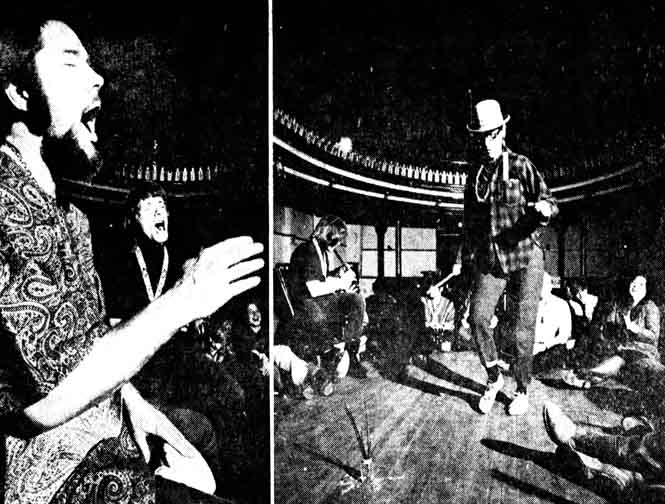
The caption for the photo above read:
The Paisleys, a Rock Group, staged a psychedelic happening in Dania Hall. Lights flashed, participants played flutes, drums and a sitar.
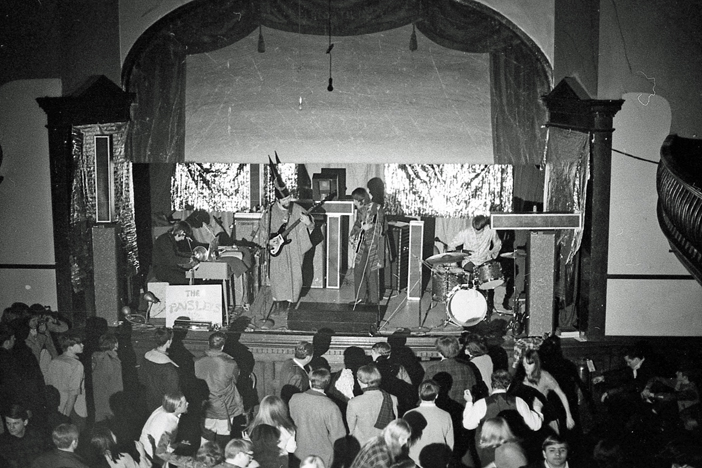
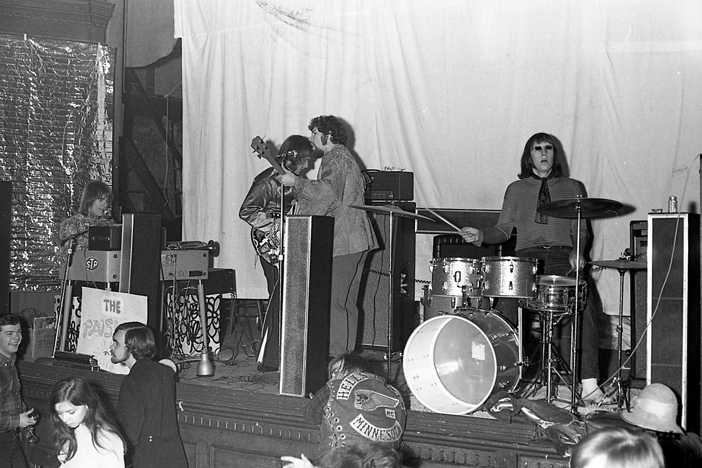
From March 17 to May 1968, Dania Hall was included in a list of Under 21 Dance Spots, open every Friday from 8:30 to 12:30.
CHRISTENSEN AT IT AGAIN
On June 12, 1968, complaints about the dances were heard by the Minneapolis City Council Licenses Committee. Alderman Jens Christensen wanted the the committee to deny the renewal of the dance hall license because he had received numerous complaints about “noise, crowds congregating on the sidewalk outside the hall and the use of vulgar language.” He quoted from an article in the Minnesota Daily, published on May 22, 1968, which quoted the manager of a dance group:
The audience is allowed to be uninhibited. At many places, cops really hassle the kids. At one place we played, two kids were necking and a cop kicked them out. At Dania everyone does what he wants.
Richter was asked to appear before the committee and show cause why the license should not be denied. (Minneapolis Star, June 12, 1968)
Meanwhile, a “Dance and Light Show” was held on June 25, 1968 – a benefit for the Twin Cities Draft Information Center.
CHARLIE THE NARC BURIES DANIA DANCES
Thanks to the testimony of 22-year-old undercover cop Wayne Billings (known by the kids as “Charlie”) before the City Council’s Licenses Committee, the committee voted to recommend to the City Council that the license not be renewed. Charlie stated that he was told that Dania was “the best place in town to make contacts for buying and selling marijuana and other drugs.”
Some local residents were in favor of the closing: “Those hippies play weird music until all hours of the night,” said a boarding house owner. A middle-aged boarder said “those hippies have been making too damn much racket.”
Not everyone wanted the hall closed. A 70-year-old lady “couldn’t understand what all the fuss was about:”
I’ve never been in the hall, but it’s nice and the city is making a big mistake by closing it because there’s a terrible need down here for recreation centers. They let all these liquor licenses stay around here but they don’t leave places for the kids.
There was a difference of opinion as to whether drug purchases were being made inside the hall or were restricted to on the street. Billings testified that he had witnessed purchases inside.
(Minneapolis Tribune, June 27, 1968)
True to form, after hearing testimony from Billings, the City Council took the License Committee’s recommendation and denied renewal of Dania’s dance-hall license with a unanimous vote. (Minneapolis Star, June 28, 1968).
Owner Phillip J. Richter said the Council’s denial of the license would force him to sell the building. (Minneapolis Tribune, June 29, 1968)
NB: I tried to find out whatever happened to our Mr. Billings, but it so happens that there are a lot of people by that name in Minnesota who would be around his age, so if you meet up with one, don’t assume it’s Charlie the Narc!
On June 30, 1968, a classified ad offered:
DANCING – Free bev. July 3rd, 9 – 1 p.m. with the Indigo Outlet. $3 singles $4 cpl. Must be 21.
PROTEST
Things got tense on July 3, 1968, when about 200 young people assembled at the Electric Fetus, then located at 521 Cedar Ave., to protest the closing of Dania Hall. Apparently the protest consisted of dancing in an empty lot. About ten Minneapolis cops, two squad cars, and a paddy wagon confronted them from across the street. In the end, the cops left with “flowers in their lapels, “Save Cedar-Riverside” buttons in their hats – and an empty paddy wagon.”
Patrolman Jack McKelvey was quoted as saying “Those kids have a point. Dania shouldn’t be closed. I’ve worked up there and I know that nothing goes on. I’ve never seen anything against the law happen there. You’ve got a good group there. Organize and go before the Council. If he (Christensen) is pressured enough, he’ll change. But if you go out and break the law today, you hurt your cause.” (Minneapolis Tribune, July 4, 1968)
HIPPIES AND RICHTER’S
In mid-August, 1968, Richter was interviewed by the Rick Edmonds of the Tribune about the hippies that congregated at his drugstore, which Edmonds termed the heart of West Bank life, and Richter called “the Hollywood and Vine of hippiedom.” Richter noted that two years ago, the clientele had been university students who had a bit of money to spend at the soda fountain, but now the kids were younger – “hippie-boppers,” he called them – who were more inclined to panhandle. They would congregate in front of the store in groups of 20 to up to 100 at a time, with police occasionally coming to shoo them away. Richter fretted that they were scaring off his regular customers, although they certainly didn’t hurt anyone. And he didn’t think drugs were much of an issue because they couldn’t afford them.
“These kids have love, you’ve got to give them that – love, and peace and freedom,” he said, preferring them to the drunks that used to inhabit Cedar Ave. Just the same, he hoped they would go home and back to school in September. (Minneapolis Tribune, August 14, 1968)
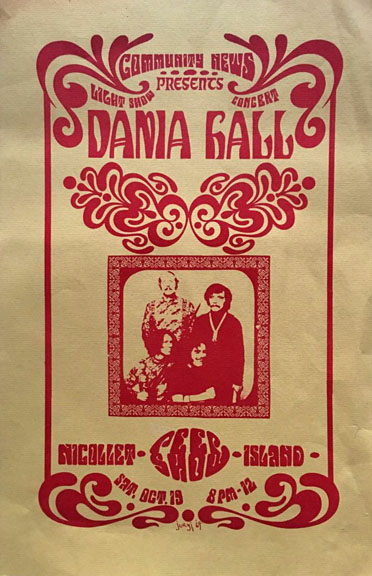
LSD NEWLY ILLEGAL
In October 1968, an 18-year-old young man from Richfield was charged with a gross misdemeanor under a new state law which prohibited the possession of LSD. The man was arrested at Dania Hall with a small plastic bottle that was analyzed and found to be the recently banned substance. The lad was given two years probation. The first states to make LSD illegal were Nevada and California in 1966. (Minneapolis Star, October 23, 1968)
RICHTER SELLS
In November 1968, Richter sold the building to Cedar Riverside Associates, “owner of considerable property in the Cedar Riverside area,” and the building was in danger of being part of a sweeping urban renewal scheme. Richter was given a long-term lease to continue running his drug store on the ground floor.
Cedar Riverside Associates was operated by Mrs. Gloria Segal, a future State legislator, and Keith Heller, a former economics professor at the U of M. At the time the firm had control of about 700 dwelling units in the area, and were hoping to come up with a plan for rehabilitation of the area by private enterprise. (Minneapolis Star, November 22, 1968)
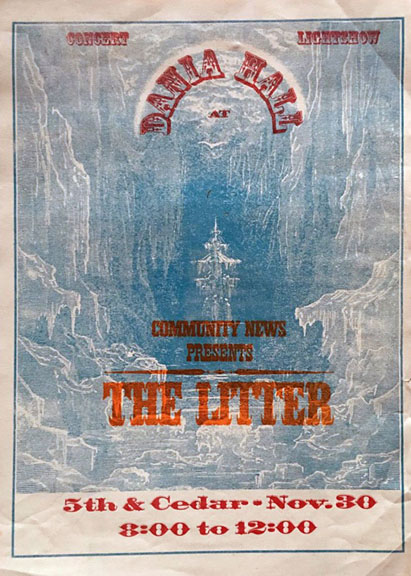
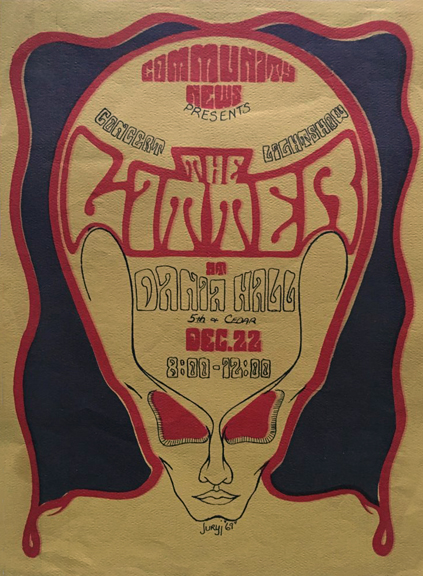
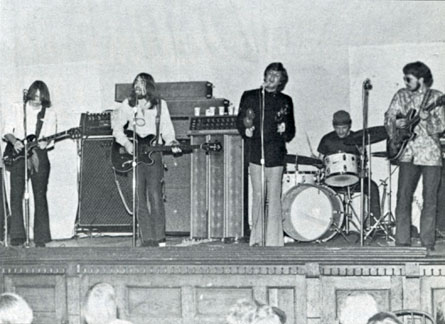
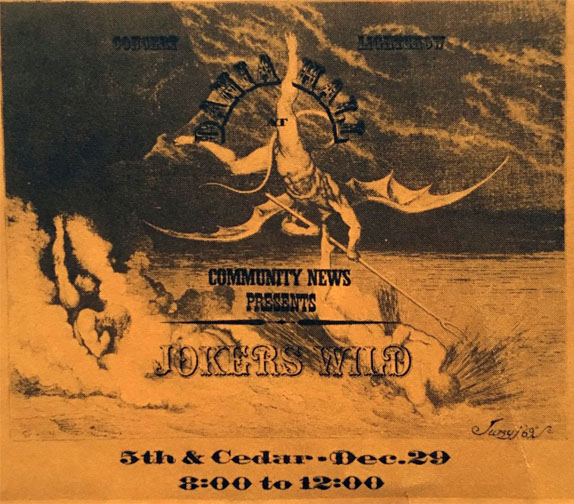
1969
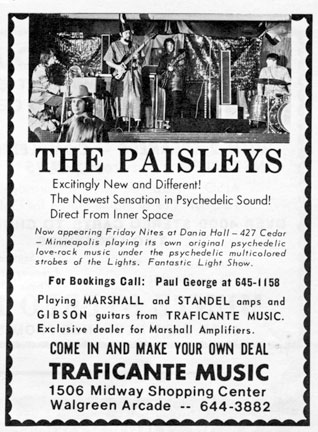
DRUG RAIDS CONTINUE
On May 24, 1969, the Minneapolis narcotics squad surrounded Dania Hall, looking for drugs and drug users. They converged on a hearse in the back of the building. Bystanders jeered the narcs and the newsmen reporting on the bust. Arrested were one 22-year-old man, a 16-year-old from St. Louis Park with a record; a 15 year-old girl; and a 13-year-old boy who threatened to shoot the police with a toy gun. Police confiscated about 400 capsules of suspected LSD and a small quantity of hashish. (Minneapolis Star and Tribune, May 26, 1969)
This is not the third floor stage – is it the second floor or a different venue altogether?
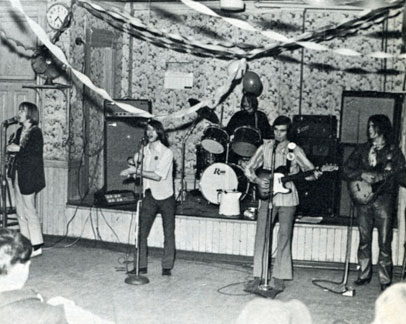
1970
In 1970 the building was owned by University Community Properties. Concerts were on again, including:
- February 15, 1970: Gas, Food, and Lodging
- February 22, 1970: Bamboo
- March 14, 1970: Bamboo and Mama’s Home Cookin’ – Brought to you by Green Toad Productions
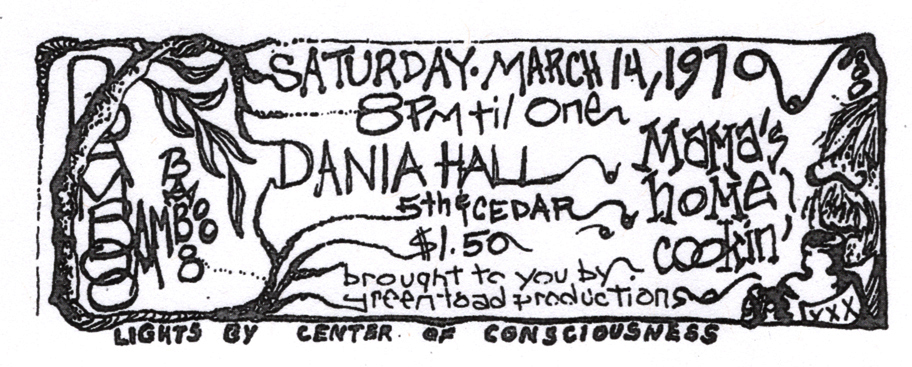
On April 4, 1970, artist Robert Rauschenberg opened his exhibition at Dayton’s Gallery 12 and held the after party at Dania Hall. Joker’s Wild provided the entertainment. The turnout was far greater than expected! (Minneapolis Tribune, April 7, 1970)
On May 1, 1970, a benefit party was planned at Dania Hall to raise money for the Black Panther Party defense fund. The benefit was sponsored by the Minneapolis Committee to Fight Repression, and activities included a light show by Center of Consciousness. Admission was $2. (Minneapolis Star, May 1, 1970)
1972
Barbara Flanagan reported that the building had been recently sandblasted in the summer of 1972.
1973
By 1973 the building was practically abandoned. The Weaver’s Guild occupied the second floor until at least until 1979.
1975
In 1975, with the help of the Danish American Fellowship and the Minnesota Historical Society, the building was put on the National Registry of Historic Places, giving it some measure of protection.
1978
Concerts resumed in 1978:
- Ambrose and Spooks: June 30
- Ambrose: July 7, 14, 21, 28
- Benefit for the Cedar-Lake Childcare Cooperative:
- Jerry Rau
- Jim Price
- Yata
- Pop Wagner
- Dick Rees
- D.G. Peterson
- Maureen McElderry
- Jeff Jordorff
- Bill Hinkley
- Judy Larson
- Barb With
- Willie Murphy and the Bees: September 15
- Willie Murphy and the Bees: September 16 – Benefit for KFAI
- Shangoya: September 22, 1978
- Rio Nido and the Radio Rangers – Hot Boogie Rent Party Benefit Dance: December 15
- Shangoya: Benefit for Sez – book of poetry: December 15, 1978
1979
- Shangoya: January 19, 1979 – Benefit for National Lawyer’s Guild
- D’Gadband: Dance for an alternative energy project: March 17, 1979
- The Wolverines: Benefit for Heart of the Beast/Powderhorn Puppet Theatre: April 13, 1979
- Explodo Boys and Good Foot: May 29, 1979
Even in the later days, musicians loved to play at Dania Hall. Johnny Hanson remembers, “The hand-carved horseshoe balcony was one of a kind…old-school craftsmanship and the room sang like a violin… just the right size…the room sang like a bird…all that wood vibrating with a crowd in a groove was one of a kind…indeed… ”
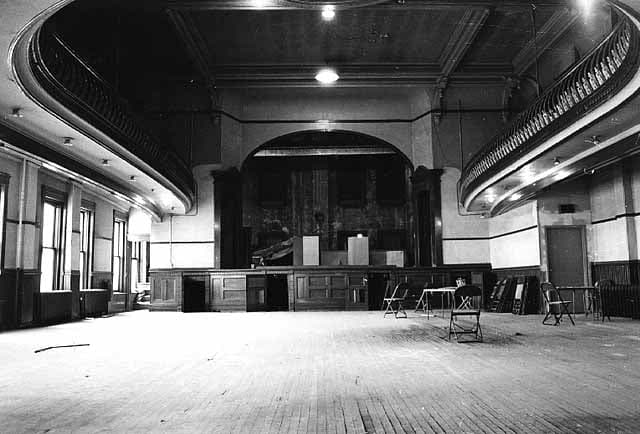
1980
Told that he had a bad heart, Richter reluctantly sold his drug store and moved to Florida. Although he was given only two years to live, he had a quintuple bypass operation and lived another 22 years.
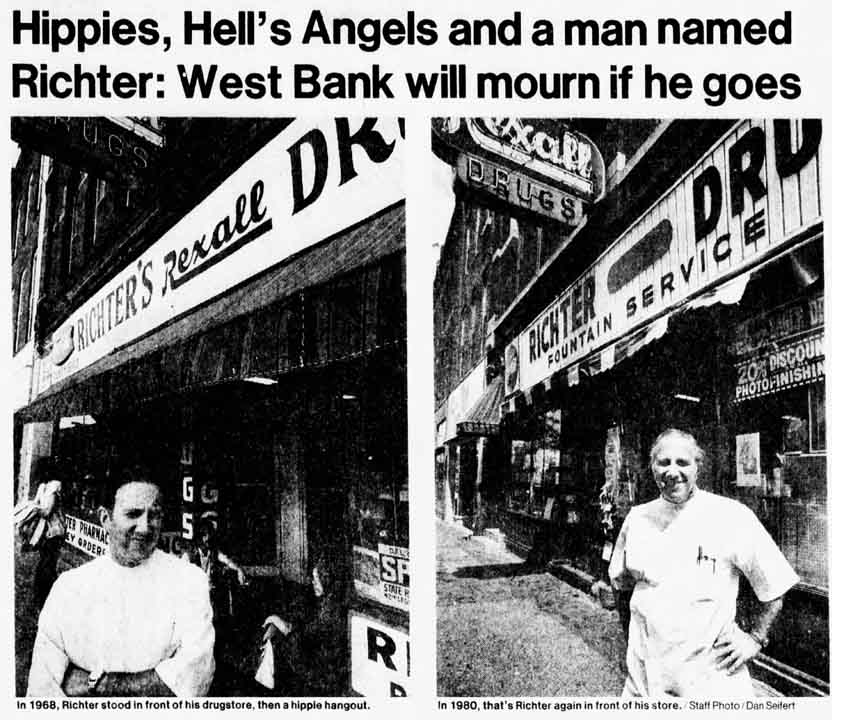
1986
The building was acquired by the Minneapolis Community Development Agency in 1986.
1987
The West Bank Theatre District celebrated its second anniversary on January 20, 1987, by reopening Dania Hall for one night. Although the building was considered unsafe for performances in its present state, it was approved for the “invitation only” celebration. (Minneapolis Tribune, January 16, 1987)
Only the first and second floors remained in use until 1991.
1991
FIRE PLAGUES THE HALL
On July 18, 1991, an early-morning fire caused extensive damage to the building. The alarm came in just after 6:15 am. It was under control by 7:45 am, but by then the roof had collapsed onto the third/fourth floor theater. The building was unoccupied and there were no injuries.
At the time the only going concerns in the building were:
- A dining hall and communal kitchen in the basement
- The West Bank Pharmacy on the first floor
- Facs, a fundraising and communications service, Terre Thomas, President – first floor
Arson was suspected in that fire after teenagers had been seen inside that night. The building was never used again. There were several plans for redevelopment, but given the building’s historic designation, it had to be restored to its original condition, which was cost prohibitive. The MCDA spent $228,000 to make basic repairs and stabilize the building. (Minneapolis Tribune, July 19, 1991)
1992 Photos from the Library of Congress, courtesy of Lyfmap.com
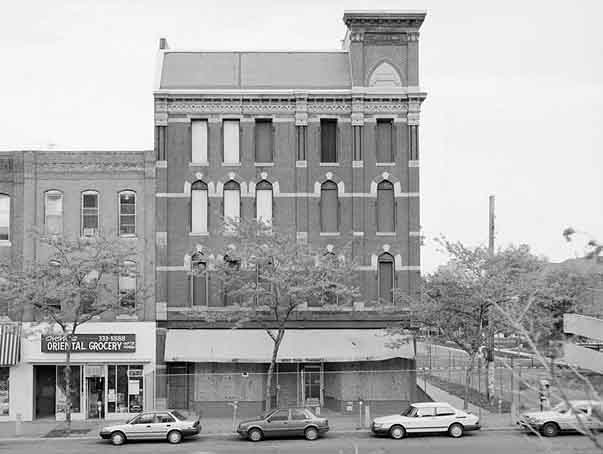
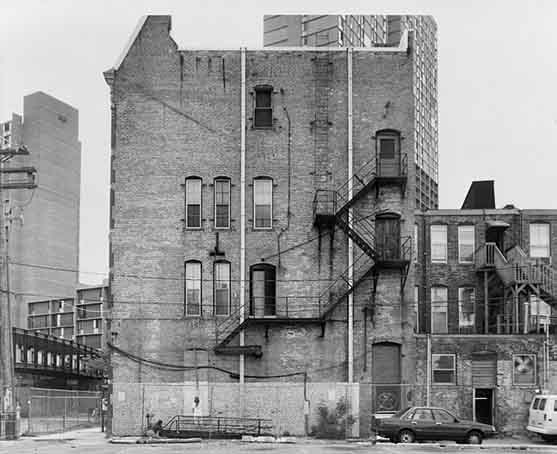
2000
DANIA BURNS TO THE GROUND
In 2000 the building was undergoing a $2.7 million renovation to be used as a cultural center with shops and a theater, begun in 1999. But on Monday, February 28, 2000, the Hall burned down in a four-alarm fire that was reported shortly after 1 am. Flames soared 70 feet into the sky and burned for more than four hours; 100 firefighters from 15 stations fought the flames. The fire spread to the adjoining Holtzermann building, forcing more than 50 residents from their apartments; 25 people were made homeless. One business in that building was destroyed and at least five others had smoke damage. The entire four-building complex had to be evacuated for lack of water and gas service. No one was injured.
In the afternoon, the wind knocked the facade down on top of burned-out cars on Cedar Ave. that had been in front of the building, and the block was closed to traffic so workers could demolish the remaining walls. The hall was owned by the Minneapolis Community Development Agency and was self-insured, so the City had to pay for the loss, including the $65,000 it cost for cleanup. The City had been planning to sell the building to private investors in two weeks; the investors would have completed the renovation and would have had insurance. An elevator shaft had just been installed, and sprinklers were planned to be installed within a month. (Minneapolis Star Tribune, February 29, 2000)
Plans for the renovated building had included a nightclub on the street level, offices on the second floor, and a third-floor theater for performances by dance groups. A pizza service was to operate in the basement. (St. Paul Pioneer Press, February 29, 2000)
The fire was attributed to a discarded cigarette; a remorseful drifter was suspected, but his only asset was a pit bull puppy, so there were no actions to charge him. (Star Tribune, March 9, 2000) It was also dubious whether a cigarette could start a wood fire of that magnatude. The cigarette theory was also highly suspect, since two loud bangs that sounded like gunshots were heard before the fire started.
Another disturbing incident was that pieces of charred wood were found on the front porch of Tim Mungavan, executive director of the West Bank Community Development Corp., which was working on the renovation. Since his house was ten blocks from Dania Hall, neither he nor the police had any explanation. (Minneapolis Star Tribune, March 1, 2000)
A neighborhood memorial service to mark the hall’s loss was held at the Cedar Cultural Center on March 2, 2000. (Minneapolis Tribune, March 9, 2000)
2002
Phillip Richter died on December 26, 2002, at the age of 81.
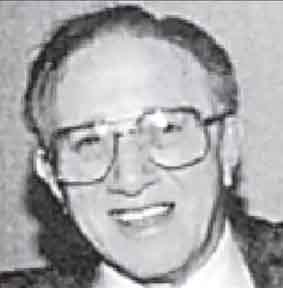
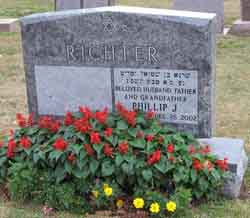
MORE
A complete history of the building is told best in a chapter of the book Swedes in the Twin Cities, edited by Philip J. Anderson and Dag Blanck (2001, MHS Press). The chapter, “Dania Hall: At the Center of a Scandinavian American Community,” was written by David Markle.
Additional sources: “Hippies, Hell’s Angels and a man named Richter: West Bank Will Mourn if he goes:” Tom Sorensen, Minneapolis Tribune, May 17, 1980


